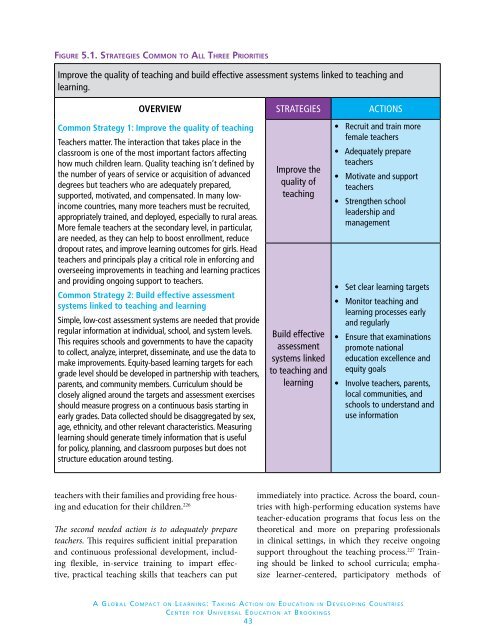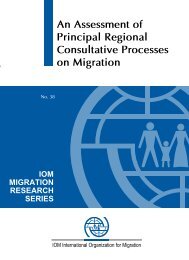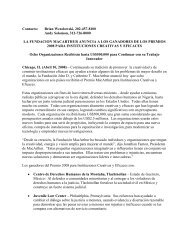A Global Compact on Learning - Brookings Institution
A Global Compact on Learning - Brookings Institution
A Global Compact on Learning - Brookings Institution
Create successful ePaper yourself
Turn your PDF publications into a flip-book with our unique Google optimized e-Paper software.
Figure 5.1. Strategies Comm<strong>on</strong> to All Three Priorities<br />
Improve the quality of teaching and build effective assessment systems linked to teaching and<br />
learning.<br />
Overview<br />
Comm<strong>on</strong> Strategy 1: Improve the quality of teaching<br />
Teachers matter. The interacti<strong>on</strong> that takes place in the<br />
classroom is <strong>on</strong>e of the most important factors affecting<br />
how much children learn. Quality teaching isn’t defined by<br />
the number of years of service or acquisiti<strong>on</strong> of advanced<br />
degrees but teachers who are adequately prepared,<br />
supported, motivated, and compensated. In many lowincome<br />
countries, many more teachers must be recruited,<br />
appropriately trained, and deployed, especially to rural areas.<br />
More female teachers at the sec<strong>on</strong>dary level, in particular,<br />
are needed, as they can help to boost enrollment, reduce<br />
dropout rates, and improve learning outcomes for girls. Head<br />
teachers and principals play a critical role in enforcing and<br />
overseeing improvements in teaching and learning practices<br />
and providing <strong>on</strong>going support to teachers.<br />
Comm<strong>on</strong> Strategy 2: Build effective assessment<br />
systems linked to teaching and learning<br />
Simple, low-cost assessment systems are needed that provide<br />
regular informati<strong>on</strong> at individual, school, and system levels.<br />
This requires schools and governments to have the capacity<br />
to collect, analyze, interpret, disseminate, and use the data to<br />
make improvements. Equity-based learning targets for each<br />
grade level should be developed in partnership with teachers,<br />
parents, and community members. Curriculum should be<br />
closely aligned around the targets and assessment exercises<br />
should measure progress <strong>on</strong> a c<strong>on</strong>tinuous basis starting in<br />
early grades. Data collected should be disaggregated by sex,<br />
age, ethnicity, and other relevant characteristics. Measuring<br />
learning should generate timely informati<strong>on</strong> that is useful<br />
for policy, planning, and classroom purposes but does not<br />
structure educati<strong>on</strong> around testing.<br />
Strategies<br />
Improve the<br />
quality of<br />
teaching<br />
Build effective<br />
assessment<br />
systems linked<br />
to teaching and<br />
learning<br />
Acti<strong>on</strong>s<br />
• Recruit and train more<br />
female teachers<br />
• Adequately prepare<br />
teachers<br />
• Motivate and support<br />
teachers<br />
• Strengthen school<br />
leadership and<br />
management<br />
• Set clear learning targets<br />
• M<strong>on</strong>itor teaching and<br />
learning processes early<br />
and regularly<br />
• Ensure that examinati<strong>on</strong>s<br />
promote nati<strong>on</strong>al<br />
educati<strong>on</strong> excellence and<br />
equity goals<br />
• Involve teachers, parents,<br />
local communities, and<br />
schools to understand and<br />
use informati<strong>on</strong><br />
teachers with their families and providing free housing<br />
and educati<strong>on</strong> for their children. 226<br />
The sec<strong>on</strong>d needed acti<strong>on</strong> is to adequately prepare<br />
teachers. This requires sufficient initial preparati<strong>on</strong><br />
and c<strong>on</strong>tinuous professi<strong>on</strong>al development, including<br />
flexible, in-service training to impart effective,<br />
practical teaching skills that teachers can put<br />
immediately into practice. Across the board, countries<br />
with high-performing educati<strong>on</strong> systems have<br />
teacher-educati<strong>on</strong> programs that focus less <strong>on</strong> the<br />
theoretical and more <strong>on</strong> preparing professi<strong>on</strong>als<br />
in clinical settings, in which they receive <strong>on</strong>going<br />
support throughout the teaching process. 227 Training<br />
should be linked to school curricula; emphasize<br />
learner-centered, participatory methods of<br />
A <str<strong>on</strong>g>Global</str<strong>on</strong>g> Compa c t <strong>on</strong> <strong>Learning</strong>: Taking Acti<strong>on</strong> <strong>on</strong> Educat i o n in Developing Countries<br />
C e n t e r for Universal Educat i o n at <strong>Brookings</strong><br />
43






